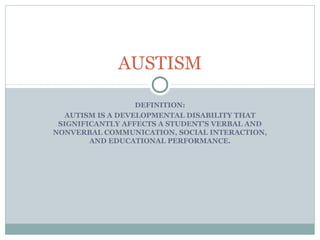Austism
- 1. AUSTISM DEFINITION: AUTISM IS A DEVELOPMENTAL DISABILITY THAT SIGNIFICANTLY AFFECTS A STUDENTŌĆÖS VERBAL AND NONVERBAL COMMUNICATION, SOCIAL INTERACTION, AND EDUCATIONAL PERFORMANCE.
- 2. History ’éŚ1908 Eugen Bleuler coined the word ŌĆ£AutismŌĆØ ’éŚ1943 Leo Kanner (American child psychiatrist) described children with common traits of Autism calling them ŌĆ£autisticŌĆØ ’éŚ1944 Hans Aperger wrote about a group of children he called ŌĆ£autistic psychopathsŌĆØ ’éŚAnd as we previously learned Brunno Bettelhelm wrote a book called The Empty Fortress and claimed that autism was due to the ŌĆ£coldness of their mothersŌĆØ
- 3. Current Info ’éŚIn the 70s, knowledge of Autism began to spread to Sweden. ’éŚIn the 80s, The Erica Foundation started education and Therapy for psychotic children. ’éŚResearch continues to occur for students with Autism since there is no proven cause, this began in the 90s and continues today. (See recent story article provided)
- 4. Causes ’éŚNo known single cause ’éŚAbnormalities in brain structure or function ’éŚMay be a link between heredity, genetics, and medical causes ’éŚMay be environmental factors such as viral infections, metabolic imbalances, and exposure to environmental chemicals
- 5. Characteristics ’éŚResistance to change ’éŚDifficulty in expressing needs ’éŚRepeating phrases in place of normal conversation ’éŚShowing distress for reasons not apparent to others ’éŚDifficulty mixing with others ’éŚLittle or no eye contact ’éŚNo real fears or dangers ’éŚUneven motor skills ’éŚNon-responsive to verbal cues
- 6. Instructional Strategies ’éŚCreate a structured, predictable environment ’éŚCreate checklists ’éŚGive fewer choices ’éŚPromote social skills (one-on-one interactions) ’éŚLimit physical contact ’éŚAdvise students of change in routine ’éŚUse signs and pictures to communicate ’éŚAllow students to stand
- 7. Classroom Management Strategies ’éŚStick to routines ’éŚVisual and written schedules ’éŚSeating arrangements ’éŚWritten task cards ’éŚWritten communication ’éŚModify the curriculum-interests ’éŚTeacher-student/ peer relationships ’éŚQuiet time ’éŚProactive management







